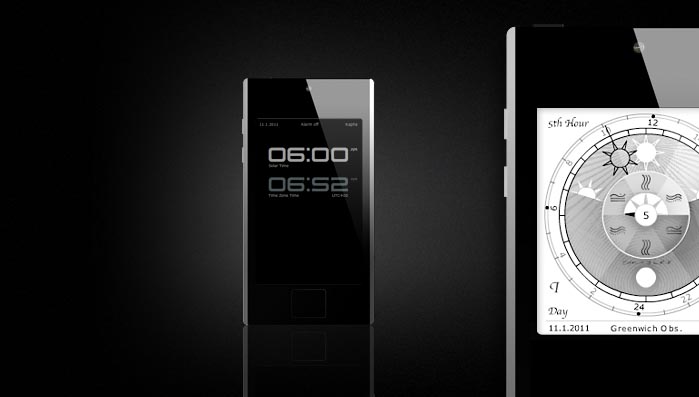
Realtime watching
The Ayurveda Sundial is a chronograph with either two numeric or two graphically depicted time dials that simultaneously show the solar time (local apparent time) and time zone time (»normal« time). For this, 24- but also 12-hour dials are used. Sun cycles and ayurvedic dosha cycles as well as conventional time can be read within one display.
Using this new relational depiction, an extended type of viewing time has been developed, which may balance some of the deficits of time zone time.
Welcome back to Realtime.


Since March 2018 until further notice no longer available. Read more …
How …
… to setup your Sundial and other tutorials you find here →. The help page is still in progress and only available in english.
Dynamic Solar Time
Just since the 14th century – with the invention and propagation of the mechanical clockwork – has a fixed determination of the hour to 60 minutes and the division of the minute into 60 seconds been defined. Dividing a day (sunrise to sunset) into twelve units (hours) already began several thousand years ago. Because the time between sunrise and sunset is longer in summer than in winter, the length of an hour varies according to the season. Thus in ancient Rome, the longest hour in a day took about 75 minutes while the shortest took approximately 45 minutes according to today’s time.
More informations, pictures and movies you find on the home page →
The Ayurveda Aspect
In the traditional Indian medicine of Ayurveda (»knowledge of life«, sanskrit: Ayus, Life und Vid, knowledge) day and night are divided into so-called doshas (essences). The »Kapha« dosha, for example, is present from 06:00 a.m. until 10:00 a.m. This time corresponds to the attributes of the representative elements (earth and water): heavy, inactive, cold, moist, etc.
It can be assumed that the essences of a particular time of day are determined primarily by the sun. Therefore the culmination of the sun is analogous to the energetic maximum in our self. At midday the »Pitta« dosha (corresponding to fire, heat, etc.) is dominant. The question is: »when is the middle of the day«?
The Ayurveda Sundial does not divide the day according to the so-called »time zones«, but is based upon the position of the sun (local apparent time). Depending on the season, therefore, the first dosha may start at 7:50, and instead of the assumed four hours, it may laast only three hours. Or you may discover that midday seldomly arrives at 12:00, but rather that the high point of the sun and with it the height of the Pitta cycle sometimes may occur hours later.
More informations, pictures and movies you find on the home page →
Features
- 6 display layouts (view →)
- Twilights phases
- GPS tracking
- Position determination over integrated online search
- File system for 4 location settings
- Time zone selection with zone map
- 3 separate alarm sections with snooze option, loop function and volume control (the options only on Android
- Local Notifications (version 1.2.2)
- Sound selection (Android only)
- 12h- and 24h-Timeformat
- And more
Devices
iPod Touch (4th Generation +)iPhone 4 and iPhone 5Android MediaplayerAndroid Smart phones (display min. 320 x 340 px, portrait)
Hardware Requirements
- GPS recommended (alternative: position input via internet or manually)
- Internet connection recommended (alternative: GPS or manually position input)
- A good docking solution → for a permanent Ayurveda Sundial (with e.g. an iPod Touch 4 or a Samsung Media Player)
System Requirements
iOS 6.1 and higherGoogle Android™ version 2.3 or higher
Application limitations
The software is not applicable north of the +65th latitude (polar region) or south of the –65th latitude (polar region).
Precision
The sundial has an exponential tolerance of ±0.5 minutes up to ca ± 5 minutes. That means, the closer you get to the polar circle, the greater is the increase of deviation. Inside polar regions calculations are partially not possible. Especially in periods of polar night/day.
Precision Relevance
The aberrations have NO relevance for the practical applicability of the sundial (excepting polar regions), because:
- Time deviations (time zone time vs. solar time) of several hours are normal.
- The mathematical horizon seldom correspond to the effective horizon height.
- The Ayurveda Sundial can not display tolerances in the scale of such small values
GPS data does not leave the Application and will not and can not be used to scan your position from outside. You keep full control.
An internet connection will only be established by the MapQuest OpenStreetMap Nominatim Service when you search for locations – comparable with a usual search engine request in your browser. Nothing else then your IP and the relevant search parameters should be transmitted. A request will never happen automatically. You keep full control.
You are able to force the App to keep awake (interface option inside the app). This is necessary if you want to have a permanent Ayurveda Sundial within a docking station. You keep full control.
Download the App
iOS version on the App Store →Android version on Google Play →
Interface Screens
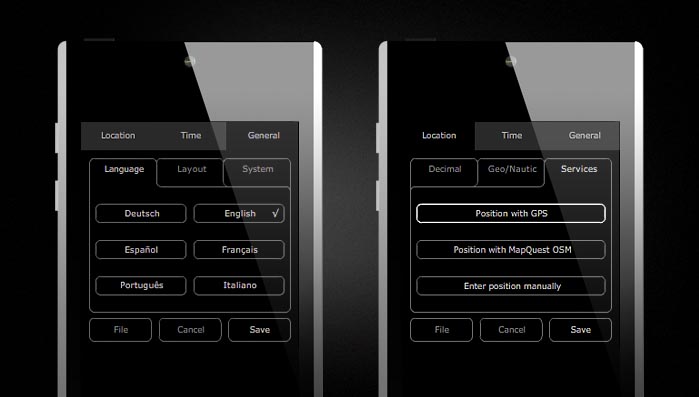
Multilingual. Simple position input.
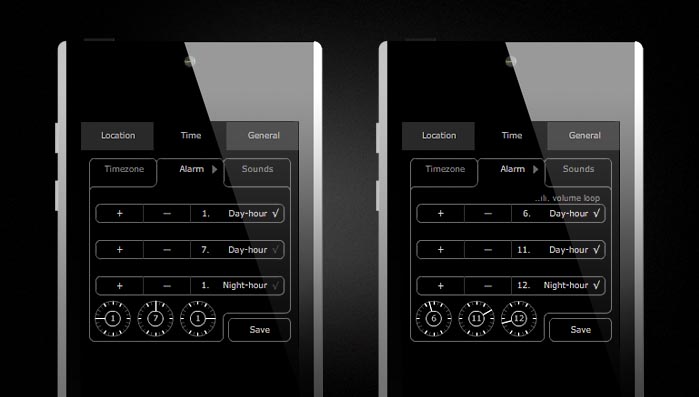
3 alarm sections with several setting options.
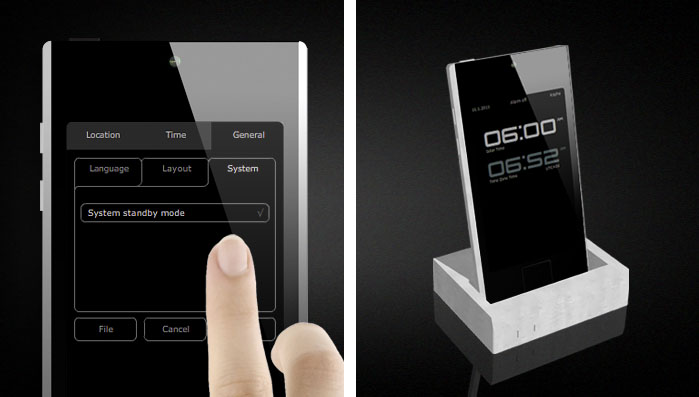
To use the alarm function a docking station → is required. It does not work in sleep mode.
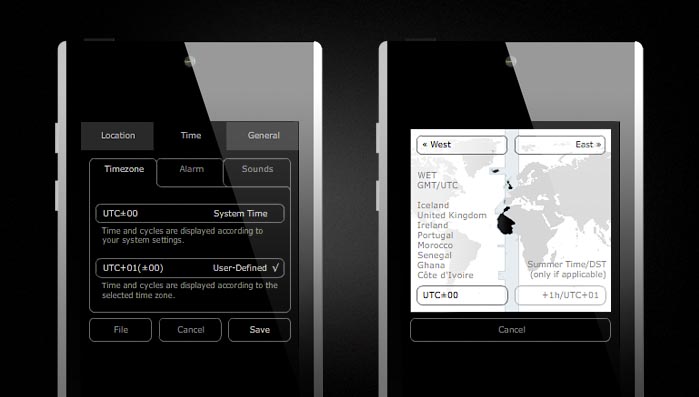
Possibility of user-defined time zone setting.
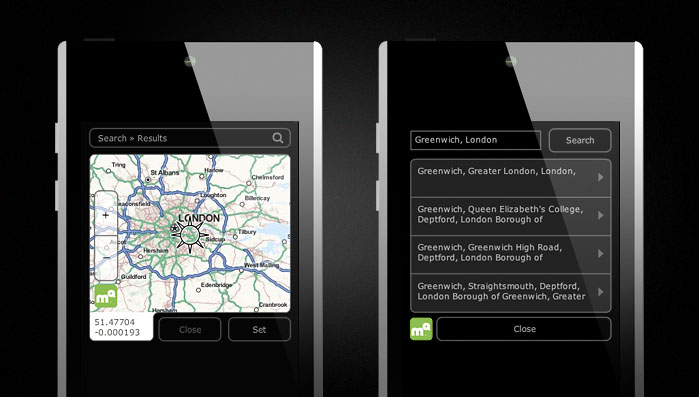
A future Version will have the Mapquest OSM Map activated. Already availible in current verson the search option (right screen).
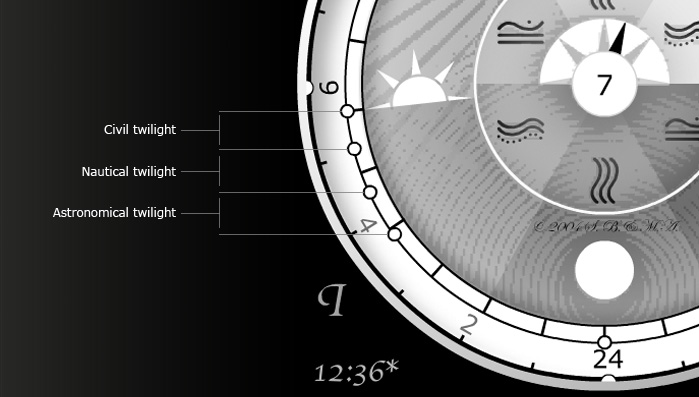
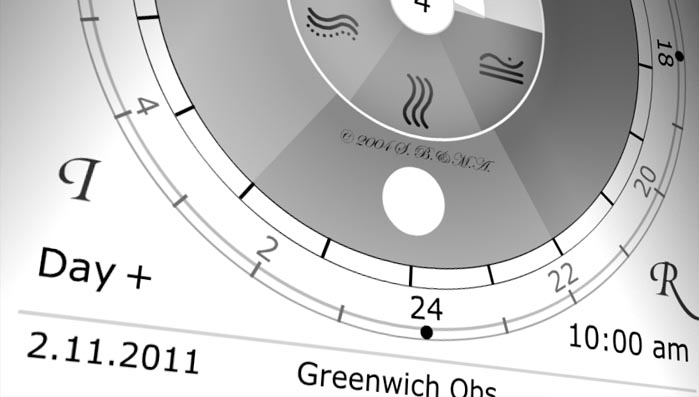
Additionally to the graphical display, a text display that shows if the days become longer (Day +/Night –) or shorter (Day –/Night +) or if an equinox is reached (Day +=) is planed.
More infos, pictures, animations and movies you find on the home page →












